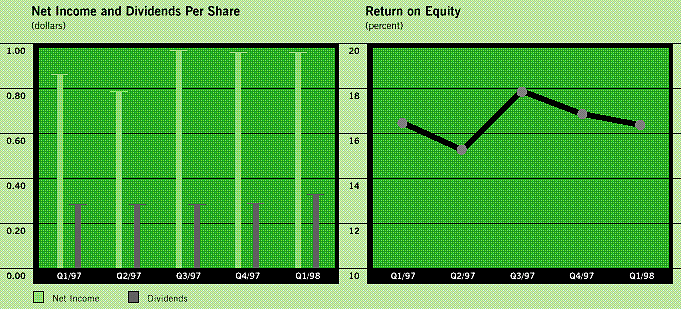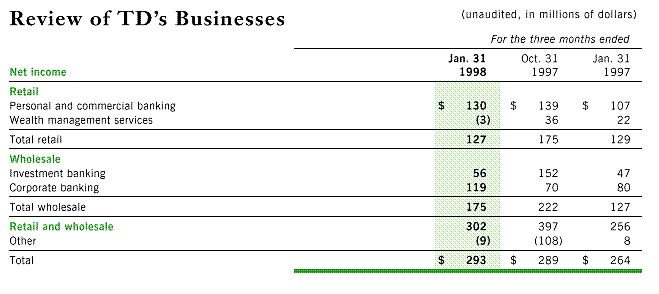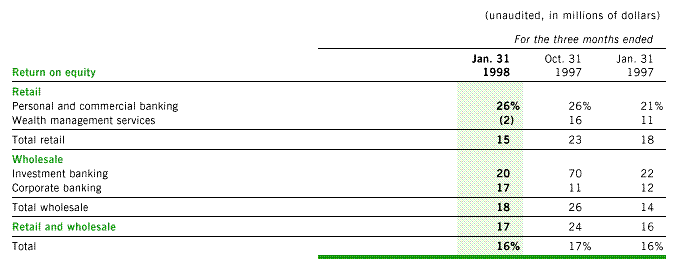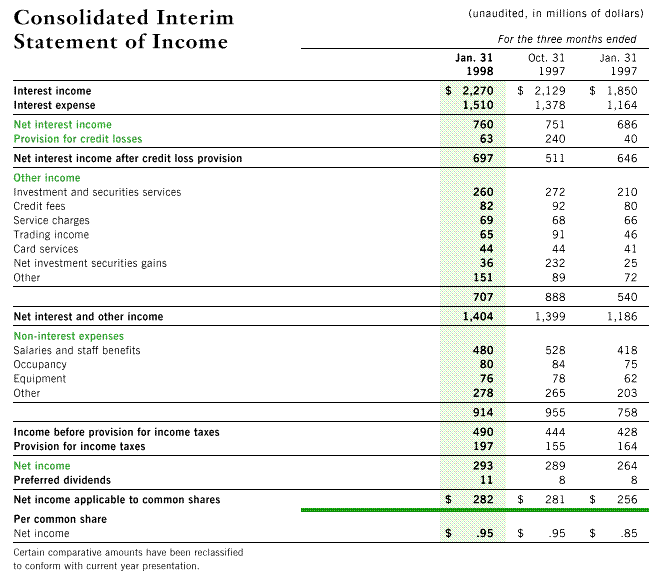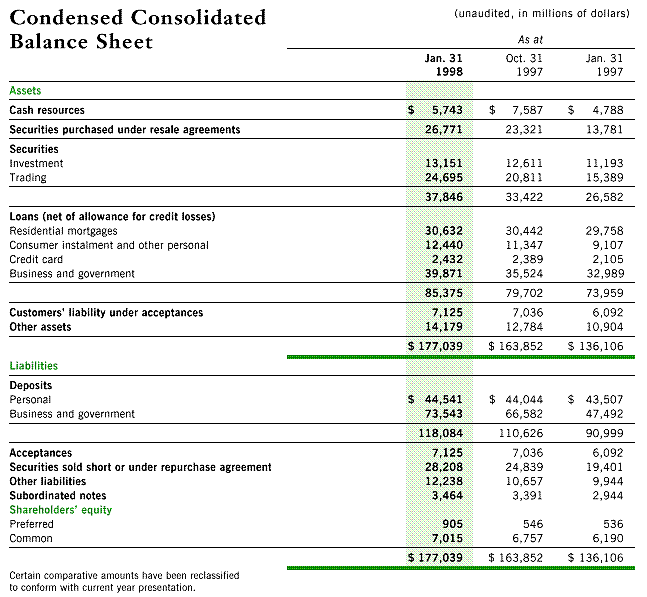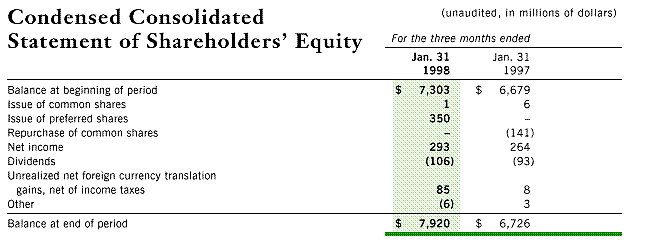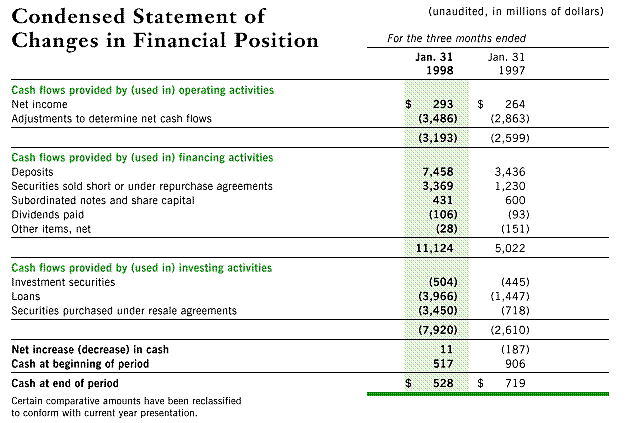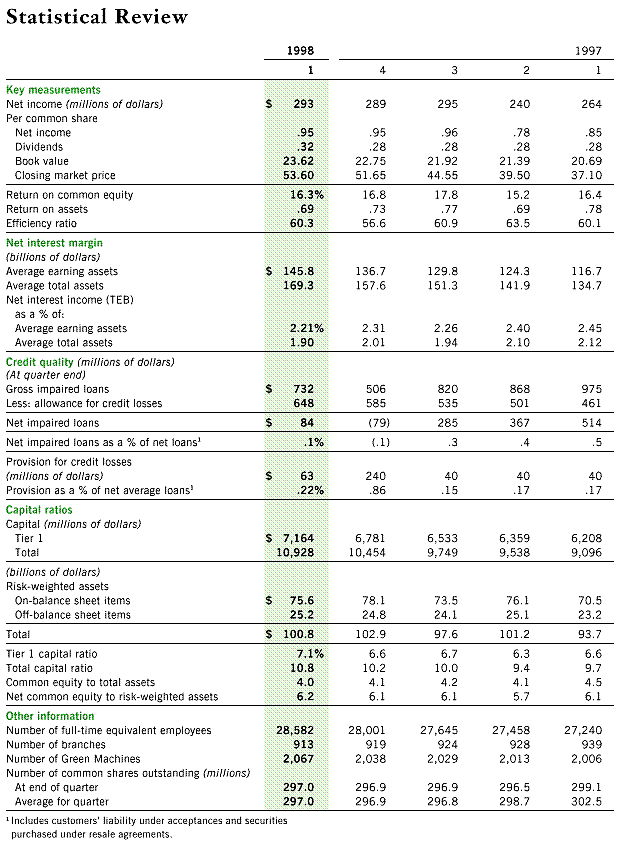Investor Relations
1998 First Quarter Report to Shareholders
|
Note: You may need to resize your browser window or
use the scrollbars to view some of the tables in this document as
they may be larger than your browser window.
Three Months Ended
January 31, 1998
Table of Financial Highlights
Letter to ShareholdersTD continued to make progress in the first quarter of 1998, with a particularly strong performance by our retail banking businesses in Canada where we saw strong year-over-year gains in revenues, earnings and market share in key areas. We are pleased to report solid earnings despite substantially higher taxes, higher loan loss provisions, and the economic and currency problems in a number of Asian economies which have had a negative impact on worldwide capital markets. Net income for the quarter of $293 million was up by 11% from the previous year; taxes and levies climbed 16% to $293 million, and loan loss provisions were $63 million, compared to $40 million in the first quarter of 1997. The provisions were increased to comply with the new regulatory initiative to set loan loss provisions at the annual average expected over an entire economic cycle, and reflect an estimate for the year of $250 million. However, actual loan losses for 1998 are not expected to be materially different from $160 million in 1997 and the higher level of annual provision will be reflected in a corresponding increase in the general reserves. Focus on credit qualityT o help keep shareholders informed about TD's credit quality, we disclosed our total credit exposure to the troubled economies of Indonesia, Malaysia, the Phillippines, South Korea and Thailand during the quarter; our exposure in these countries totals $915 million, or less than 1% of assets.Helping to make it easierO ur advances in retail banking are due largely to our staff's efforts to help make it easier for customers through the expansion of TD Access distribution channels and our ongoing focus on excellence in customer service and sales. As well as being reflected in the bottom line, our success in quality service delivery has been confirmed by independent customer surveys. We are very proud to report that, during the quarter:
Significant achievementsI n other operating highlights during the quarter:
Recognizing the people of TDW e are very proud of the efforts of staff throughout Québec, Eastern Ontario and Atlantic Canada – and the support of our people across the country – who worked to minimize service interruptions and to provide assistance and relief during the devastating ice storms in January. As part of these efforts, TD made a corporate donation of $200,000 to the relief fund, TD employees donated $40,000 and customers donated over $120,000 through our branch network. The special efforts continue throughout the ice storm regions, as our people work with customers to help them get back to business as usual.Outlook: The Asian currency crisis and its aftermath have dampened projections for global growth in 1998. In Canada, low commodity prices and somewhat higher interest rates have tempered the forecasts to a degree. Although growth will slow from last year’s rapid pace – especially in British Columbia – we still anticipate healthy growth of about 3% in Canada and over 2% in the United States this year. In this environment, we expect our businesses to make further progress in the months ahead. Debate on the future of bankingT he announcement of the proposed merger of two of Canada’s major banks during the quarter has presented a significant market opportunity for us. Our success in gaining share in our core businesses indicates that we are well positioned to continue to outperform the competition. While the impact of bank mergers warrants full review and public debate in Canada, we hope this issue does not overshadow other important areas of financial services reform such as bank entry into insurance and leasing businesses where we can enhance competition and better meet the needs of Canadian consumers.
Toronto, February 26, 1998 On February 1, 1998, A. Charles Baillie, President and Chief Executive Officer since February of 1997, became Chairman of the Board on the retirement of Richard M. Thomson. Mr. Thomson will continue to serve TD as a member of the Board of Directors.
Personal and Commercial BankingN et income for Personal and Commercial Banking was up $23 million or 21% over the first quarter of last year. Net interest income grew $21 million or 4% primarily due to higher average earning assets. Strong growth continued in residential mortgages with average volumes, including securitizations, increasing 9% and personal loans increasing 8%. Margins were relatively stable. The yield curve was flatter and short term interest rates were 117 basis points higher this quarter than last year. These factors led to an improvement in margins on core deposits, offset by reduced earnings on the interest rate gap position and a decline in loan margins. Other income increased $25 million or 14% driven by higher commercial lending activity and higher credit card, mortgage servicing and insurance revenues.The efficiency ratio improved to 63% from 67% a year ago as expenses declined 1%. The increase in provision for credit losses was caused by additions to the general provision reflecting the estimated average annual experience over a credit cycle. Strong revenue growth coupled with expense containment resulted in return on equity increasing from 21% last year to 26%. Wealth Management ServicesW ealth Management net income remained at the same level as last year after adjusting for the $25 million cost of acquiring Rivkin Croll Smith in Australia, which was expensed in full during the quarter. Brokerage commissions and mutual fund management fees grew 20% over last year despite slower market activity in Canada.Assets under management at our full service broker, Evergreen, climbed above $10 billion, an increase of 54% from a year ago. The Asian situation, declining Canadian dollar and rising interest rates sidelined Canadian retail investors and left trading volume flat from prior year levels at Green Line and Evergreen. Compared with a year ago, Waterhouse active customer accounts have grown 71% while trading volume increased by almost 100%. Increased activity is in part attributable to Web trading, and the addition of Kennedy Cabot in California. TD Asset Management enjoyed continued growth in retail mutual fund volumes, showing an increase of 22%. Net income before the Rivkin Croll Smith acquisition expense was down $13 million from the prior quarter reflecting lower trading volumes throughout North America and higher expenses in preparation for RSP season in brokerage and mutual funds.
Investment BankingI nvestment Banking improved its net income by $9 million over last year.Foreign exchange, money market and funding, capitalizing on market volatility, have all experienced revenue growth in excess of 50% from last year. Domestic fixed income, Eurobonds and high yield businesses have also had impressive underwriting and trading results. Compared to the fourth quarter of 1997, net income improved by $19 million after adjusting for the impact of $200 million in special securities gains realized that quarter. Corporate BankingC orporate Banking earned a 13% return on equity this quarter after excluding the $29 million after-tax gain on the sale of TD’s payroll services business.Net interest income was up 14% from the first quarter of 1997. The increase resulted from improved margins in Canada and improved volume in the U.S. The segment’s net income was also aided by a provision for credit loss that was down substantially from last quarter, when general provisions were increased. Review of Operating PerformanceNet income in the first quarter of 1998 was $293 million. This is an increase of $29 million or 11% from the first quarter of 1997. Net interest income reached a recorded $810 million, 13% better than the first quarter last year, with other income of $707 million ahead 31% from last year.Earnings per share in the quarter were $.95, which is an increase of $.10 or 12% from last year and equal to last quarter’s performance. Return on common equity was 16.3% in the quarter compared to 16.4% last year. There is increasing focus on the impact of different accounting treatments between Canada and the United States, with respect to acquisitions, on earnings and return on equity. Excluding goodwill from both net income and equity allows for a more meaningful comparison. On a goodwill-adjusted basis, earnings per share and return on equity would be $1.07 and 20.6% respectively this quarter compared to $.87 and 18.3% last year. Our performance in the first quarter of fiscal 1998 represents an encouraging start to the new year. Net Interest IncomeN et interest income on a tax equivalent basis increased $90 million or 13% from last year to $810 million this quarter. This growth in net interest income was a result of a 25% increase in average earning assets, which grew to $145.8 billion from $116.7 billion last year. The majority of this strong asset growth continues to be trading securities and securities purchased under resale agreements. These assets, which support our increased investment banking activities, have minimal credit risk and contribute to net income but earn a lower margin than other intermediation products. This change in the mix toward lower margin assets as well as lower margins resulting from a flatter yield curve contributed to a 24 basis point decline in margin from the first quarter last year.Credit Quality and Provision for Credit LossesC redit quality continues to be high, notwithstanding the turmoil experienced by the Asian economies during the quarter. Net impaired loans were $84 million at the end of the first quarter – $430 million lower than first quarter last year. Net impaired loans increased from last quarter primarily due to the reclassification of our exposure to a single corporate borrower in the United States. At the end of this quarter net impaired loans were only .1% of total loans compared to .5% last year.The full year estimate for provision for credit losses in 1998 is $250 million. This estimate is $90 million higher than our 1997 provision for credit losses of $160 million, excluding the special increase in general provisions of $200 million in the fourth quarter of that year. The increase over 1997 will contribute to additional general provisions and is based on establishing the total provision for credit losses at the estimated annual average experience over a credit cycle. One quarter or $63 million of the full year estimated expense was taken this quarter. Other IncomeO ther income had another solid quarter producing $707 million in revenues, which is $167 million or 31% higher than the same quarter last year. Other income includes a $46 million pre-tax gain from the sale of our payroll services business and reflects strong growth from our global discount brokerage operations – specifically in the U.S. with the inclusion of California discount broker Kennedy, Cabot & Co. into Waterhouse Securities and in Australia where we have combined discount brokers Pont Securities and Rivkin Croll Smith to create Green Line Australia. Excluding these factors from the quarter, other income increased 17% over last year. This performance continues to be broadly based and reflects our strategy of investing in wealth management businesses and expanding TD Securities’ businesses. Within TD Securities, underwriting, mergers and acquisitions, equity trading and foreign exchange made strong contributions to our performance. Revenue from our family of 39 Green Line No-Load Mutual Funds grew 45% over last year.TD’s investment portfolio of securities continued to perform well, realizing $36 million in net investment securities gains in the quarter. Non-Interest ExpensesE xpenses grew by 21% in line with the 20% increase in total revenues. This quarter’s expenses include the $25 million after-tax cost of our acquisition of Australian discount broker Rivkin Croll Smith and this accounts for over 3 percentage points of the growth in expenses. Of the remaining growth, 14 percentage points is attributable to revenue growth in our TD Securities businesses and global discount brokers and 3 percentage points is the increase in base expenses.Our reported efficiency ratio this quarter was 60.3%, which is a 20 basis point deterioration over last year. Excluding goodwill and one-time gains our efficiency ratio is virtually flat at 59.7% versus 59.6% last year. Balance SheetT otal assets as at January 31, 1998 were $177 billion which is an increase of 30% or $41 billion from a year ago. The majority of this growth continues to be a result of higher securities purchased under resale agreements and other trading securities balances. However the strength of the Canadian consumers’ confidence and increases in our market share have allowed us also to experience strong growth in residential mortgages and personal loans. Compared to last year mortgages, including $2.4 billion in securitizations during the year, grew 11% or $3.3 billion and personal loans, including credit cards, increased 33% or $3.7 billion. The strong personal loan growth has been assisted by Waterhouse Securities which has experienced a $1.7 billion increase in personal loans since the first quarter of last year, from $.8 billion to $2.5 billion. In addition, business and other loans increased 21% or $6.9 billion over last year.Personal non-term deposits increased 12% or $2.3 billion over last year of which $1.8 billion was from increasing activity in Waterhouse Securities which saw deposit volume more than double from last year. Mutual funds under management in Canada increased 22% or $2.4 billion over last year while term deposits declined 5% or $1.2 billion from last year. Waterhouse also continues to experience growth in mutual funds which increased 74% or $3.3 billion over last year. Total mutual funds under management at January 31, 1998 were $21.2 billion, an increase of $5.7 billion or 37% from last year. The surplus of market over book value of the Bank’s securities portfolios at the end of the quarter was $753 million. This is an increase of $322 million from last year. CapitalC ommon equity increased $258 million in the quarter primarily due to net income after dividends of $187 million in the quarter. Common equity also increased $76 million from foreign currency translation gains due to the Canadian dollar weakening, relative to other currencies, as at January 31, 1998.The ratio of net common equity to risk-weighted assets increased 10 basis points from 6.1% at October 31, 1997 to 6.2% at January 31, 1998 reflecting both the increase in common equity described above, partially offset by the goodwill arising from our purchase of Kennedy, Cabot & Co. and lower risk-weighted assets. The latter reflects a change by the Office of the Superintendent of Financial Institutions to the calculation of risk-weighted assets as applied to trading securities, and our initiatives to actively manage our capital requirements. During the quarter we insured $4.5 billion of conventional residential mortgages with Canada Mortgage and Housing Corporation and securitized $400 million in mortgages which reduces the regulatory capital requirements for these loans. These events more than offset the increase in risk-weighted assets from business growth. Our Tier 1 and total capital ratios also benefitted from our issuing $350 million in Tier 1 preferred shares, and increased to 7.1% and 10.8%, from 6.6% and 10.2%, respectively.
|


